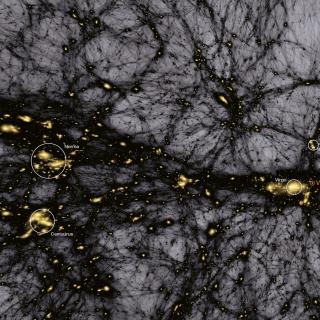Bibcode
Knebe, Alexander; Lopez-Cano, Daniel; Avila, Santiago; Favole, Ginevra; Stevens, Adam R. H.; Gonzalez-Perez, Violeta; Reyes-Peraza, Guillermo; Yepes, Gustavo; Chuang, Chia-Hsun; Kitaura, Francisco-Shu
Referencia bibliográfica
Monthly Notices of the Royal Astronomical Society
Fecha de publicación:
3
2022
Número de citas
9
Número de citas referidas
9
Descripción
New surveys such as European Space Agencys (ESA's) Euclid mission are planned to map with unprecedented precision the large-scale structure of the Universe by measuring the 3D positions of tens of millions of galaxies. It is necessary to develop theoretically modelled galaxy catalogues to estimate the expected performance and to optimize the analysis strategy of these surveys. We populate two pairs of (1 h-1 Gpc)3 volume dark matter-only simulations from the UNIT project with galaxies using the Semi-Analytic Galaxy Evolution semi-analytic model of galaxy formation, coupled to the photoionization model GET_EMLINES to estimate their H α emission. These catalogues represent a unique suite that includes galaxy formation physics and - thanks to the fixed-pair technique used - an effective volume of $\sim\!(5\,h^{-1}\,\rm {Gpc})^3$, which is several times larger than the Euclid survey. We present the performance of these data and create five additional emission-line galaxy (ELG) catalogues by applying a dust-attenuation model as well as adjusting the flux threshold as a function of redshift in order to reproduce Euclid-forecast dN/dz values. As a first application, we study the abundance and clustering of those model H α ELGs: for scales greater than ~5 h-1 Mpc, we find a scale-independent bias with a value of b ~ 1 at redshift z ~ 0.5, that can increase nearly linearly to b ~ 4 at z ~ 2, depending on the ELG catalogue. Model galaxy properties, including their emission-line fluxes (with and without dust extinction) are publicly available.
Proyectos relacionados

Cosmología con Trazadores de la Estructura a Gran Escala del Universo
El Fondo Cósmico de Microondas (FCM) contiene la información estadística de las semillas primigenias que han dado lugar a la formación de todas las estructuras en el Universo. Su contrapartida natural en el Universo local es la distribución de las galaxias que surgen como resultado del crecimiento gravitatorio de aquellas fluctuaciones de densidad
FRANCISCO SHU
KITAURA JOYANES